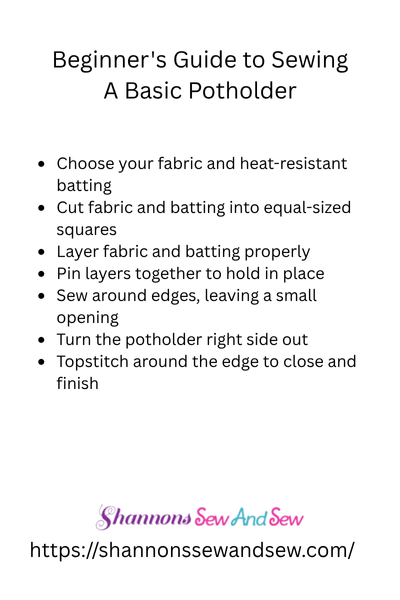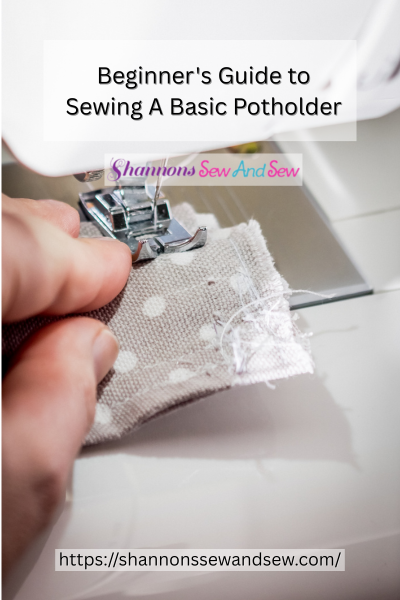Sewing For Beginners
Beginner’s Guide to Sewing a Basic Potholder
If you’ve ever wondered where to start with sewing, the beginner’s guide to sewing a basic potholder might just be your golden ticket.
I totally get it—sewing can feel intimidating at first. I remember staring at my dusty old sewing machine like it was a spaceship. What were all those buttons for? Why did the bobbin always tangle like a mischievous kitten had gotten into it? But trust me, once you make your first simple project, especially something as useful as a potholder, you’ll start feeling like a sewing ninja in no time.
Read More About Beginner’s Guide to Sewing a Basic Potholder

Why Start With a Potholder?
Here’s the thing: potholders are small, forgiving, and super functional. No one expects them to look runway-ready, but they do need to work. That’s what makes them the perfect beginner project. You’ll get to practice straight stitches, work with different layers, and see your fabric turn into something real you can use every day—or gift to someone who’ll definitely appreciate your effort.
And let’s be honest—there’s something ridiculously satisfying about pulling a hot tray of cookies from the oven with something you made. I still use the first potholder I ever stitched together, even though it’s a little crooked. It’s kind of like a badge of honor now.
More Things to Know About Beginner’s Guide to Sewing a Basic Potholder

Getting the Right Materials
Before you dive into this beginner’s guide to sewing a basic potholder, you’ll need a few things. I know, shopping lists aren’t the fun part, but once you have these on hand, you’re golden:
- Two 8×8″ squares of cotton fabric (think fun prints or whatever you’ve got lying around)
- One 8×8″ square of insulated batting (like Insul-Bright—it protects your hand from heat)
- One 8×8″ square of cotton batting or a thick towel scrap (extra padding)
- Thread (all-purpose works great)
- Scissors or rotary cutter
- A loop (bias tape, ribbon, or just make one from fabric)
If you’re like me and you tend to go rogue in fabric stores, consider this fair warning: you will walk out with more than you planned. But hey, no shame in a little extra inspiration.
Let’s Get Sewing!
Alright, now the fun starts. Here’s how you tackle the project, one step at a time. Follow this beginner’s guide to sewing a basic potholder and you’ll be stitching with confidence.
First, layer your fabric like this: bottom fabric (pretty side down), then the cotton batting, then the insulated batting, and finally the top fabric (pretty side up). Think sandwich—except less tasty and more crafty.
Pin the layers together so nothing wiggles. Sew a few straight lines across the potholder (I like to go diagonally from corner to corner) to keep the layers in place. This is called quilting, but don’t let the fancy word scare you off—it’s basically just sewing straight lines.
Once you’ve quilted the piece, it’s time to add the binding around the edges. This can be the trickiest part, but also the most satisfying. You’ll take your bias tape or fabric strip and fold it around the edge, then sew it down, making sure to catch both sides. Go slow here—seriously, no one’s judging your speed.
Don’t forget to add your loop in one corner! That way, you can hang it like a pro.
When Things Don’t Go as Planned
Let’s have a real talk moment: something will probably go a bit sideways. Maybe your stitches won’t line up. Maybe your machine eats the fabric (ugh, the worst). Maybe you’ll sew the loop on the wrong corner. I’ve done all that and more.
But honestly? That’s part of the charm. Every mistake teaches you something, and with each potholder you make, you’ll get better. I still laugh thinking about the one I sewed shut completely by accident—no opening, no turning it right side out. It looked like a sad little fabric pancake.
So don’t sweat it. Perfection is overrated, and every potholder you make tells a story—your story.
Why You’ll Want to Make More
Once you’ve followed this beginner’s guide to sewing a basic potholder, you might get hooked. These little fabric squares are great scrap-busters, fun to customize, and surprisingly addictive. Plus, they make thoughtful gifts. Birthdays, holidays, housewarmings—you name it. One time, I gave a stack of them to a buddy who’d just moved into a new place. He looked at me like I handed him gold.
And if you’re a guy wondering if sewing is your thing? Heck yes, it is. Anyone who can handle tools can handle a sewing machine. It’s just another kind of power tool, honestly—one that lets you create stuff out of fabric instead of wood or metal.
Wrapping Up: The Power of a Simple Project
So there you have it—your beginner’s guide to sewing a basic potholder. Not so scary, right? With just a few materials, a bit of patience, and a willingness to laugh off your goof-ups, you’re on your way to building solid sewing skills.
And hey, if a potholder is where you start, who knows where you’ll end up? Aprons, bags, even quilts? But let’s not get ahead of ourselves.
For now, go make that potholder—and don’t forget to use it with pride.




















